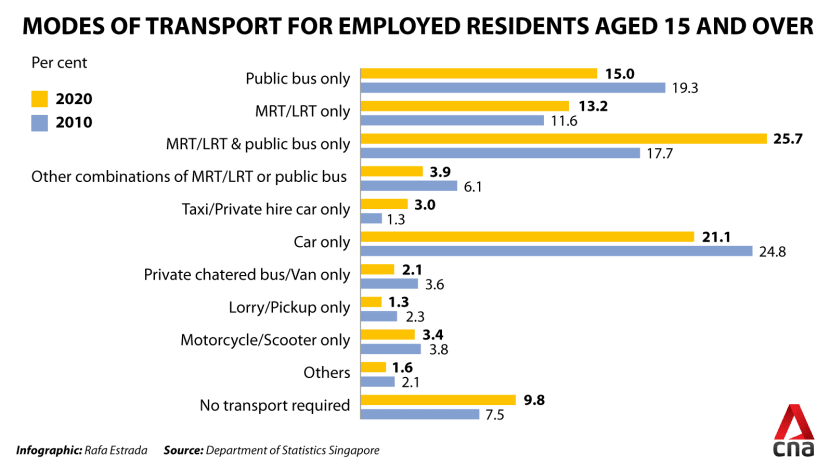Fewer residents driving to work; downtown core the top workplace destination: Population census
SINGAPORE: Fewer residents have been driving to work over the past decade and more have been turning to public transport instead.
This was among the findings by the Department of Statistics (DOS) as it released further details on Friday (Jun 18) from the census of population that is conducted once every 10 years.
READ: Slowest decade of population growth in Singapore since independence: Census 2020
About a quarter of all residents used to drive a car to work in 2010. But a decade later, this group had dwindled to about one-fifth of respondents.
On the other hand, the proportion of those who took public transport such as trains and public buses to work rose from 54.6 per cent in 2010 to 57.7 per cent in 2020.
This is in line with the expansion of the train networks, the census stated.

There was also a small increase in the proportion of those who took private-hire cars or taxis only. But other modes of transport such as chartered buses, lorries, motorcycles saw a lower proportion of users.
The census of population is the largest national survey undertaken in Singapore to collect statistics such as demographic, social and economic data.
It covered 150,000 households last year. Respondents were asked questions based on their usual travel and work arrangements, barring the COVID-19 pandemic.
BY HOUSING ESTATE
About 63 per cent of residents in Toa Payoh travelled to work using combinations of trains or buses – the highest proportion among commuters in other housing estates.
This was followed closely by residents in Sembawang, Bukit Merah and Queenstown.
Meanwhile, the proportion of those who only took public buses to work was higher in Marine Parade and Bukit Merah.
In contrast, the proportion of those who travelled by car was higher in Tanglin and Bukit Timah.
MEDIAN TRAVELLING TIME
Median commute times to work were longer in 2020 than in 2010 for all forms of public transport.
This was likely due to longer distances travelled via these transport modes, the census noted.
READ: Public transport satisfaction dips in 2020, MRT safety scores largest improvement: Survey
But in line with data from a decade ago, commutes via public buses in 2020 remained shorter than trains, or a mix of public transport modes.
Commutes on private transport modes like cars, lorries and motorcycles also remained shorter than those for public transport.
WHERE DID PEOPLE WORK?
Nearly 13 per cent of Singapore’s resident workforce – or 284,000 people aged 15 and above - worked in the downtown core.
The figure is more than double the next area listed, which is Queenstown, at 6 per cent or 131,800 of such workers.
Data also showed that workers in the downtown core were younger compared to other areas. About 66 per cent of workers there were below 45 years old, compared to about 44 per cent in Bedok, which had the smallest proportion of younger workers.
The downtown core also had the most workers with post-secondary qualifications or higher.
HOW FAR FROM WORK?
The downtown core was the top workplace destination in 2020 for residents living across all five regions: Central, East, North, North-East and West.
It accounted for about 10 to 21 per cent of the resident workforce from each of these regions – with the most workers travelling from the Central region.
The census also found that almost 80 per cent of the resident workforce worked in a different planning area from their homes in 2020.
Only about 9 per cent lived and worked in the same area, while about 3 per cent said they worked from home.
READ: Commentary: When Singapore homes become workspaces – huge changes in the house and beyond
Speaking at a media briefing, Ms Indranee Rajah, Minister in the Prime Minister’s Office who oversees the National Population and Talent Division, said that such geographical data on where and how people work and live is useful in urban planning.
“(We hope to) have more people be able to work, live, and play near their areas of residence. We've also had to think about work from home,” she said.
“This data is helpful to let you know in terms of geographical distribution, helps you to plan for things across the board, for transport, for town planning, master planning.”












